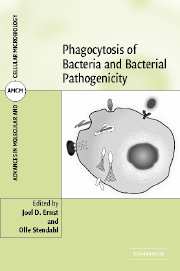Book contents
- Frontmatter
- Contents
- List of contributors
- 1 Introduction
- 2 Phagocytosis: receptors and biology
- 3 Receptor-initiated signal transduction during phagocytosis
- 4 Life, death, and inflammation: manipulation of phagocyte function by Helicobacter pylori
- 5 Phagocytosis of Streptococcus pneumoniae
- 6 Yersinia inhibition of phagocytosis
- 7 Listeria invasion and spread in non-professional phagocytes
- 8 Mycobacterium tuberculosis: mechanisms of phagocytosis and intracellular survival
- Index
- Plate section
- References
6 - Yersinia inhibition of phagocytosis
Published online by Cambridge University Press: 07 August 2009
- Frontmatter
- Contents
- List of contributors
- 1 Introduction
- 2 Phagocytosis: receptors and biology
- 3 Receptor-initiated signal transduction during phagocytosis
- 4 Life, death, and inflammation: manipulation of phagocyte function by Helicobacter pylori
- 5 Phagocytosis of Streptococcus pneumoniae
- 6 Yersinia inhibition of phagocytosis
- 7 Listeria invasion and spread in non-professional phagocytes
- 8 Mycobacterium tuberculosis: mechanisms of phagocytosis and intracellular survival
- Index
- Plate section
- References
Summary
THE YERSINIA INFECTION
There are three human pathogenic Yersinia species: Y. pestis, Y. enterocolitica, and Y. pseudotuberculosis (Smego et al. 1999; Sulakvelidze 2000). Y. pestis is the causative agent of bubonic plague and has been responsible for the deaths of millions of people over the years. This pathogen is transmitted to humans by the bite of an infected rodent flea. Once inside, the bacteria initially invade and proliferate in lymphatic tissue. Y. enterocolitica and Y. pseudotuberculosis cause enteric infections (yersinosis) in humans. These are transmitted to humans by infected beverages and food or by direct contact with infected mammals; pigs are the major reservoir (Bottone 1999; Smego et al. 1999). Despite having a different route of infection, the orally transmitted non-plague Yersinia species also exhibit tropism for lymphoid tissue. The infection route occurs through the ileal mucosa in the gastrointestinal tract, where they are taken up into the lymphoid follicles through M-cells. These specialized cells cover the lymphoid follicles of Peyer's patches and engulf bacteria in a way that resembles active phagocytosis (Grassl et al., 2003). The bacteria multiply within the Peyer's patches, which are intestinal lymphoid nodules that contain B and T lymphocytes and phagocytes, and then drain to mesenteric lymph nodes. At this location, Yersinia encounters cells of the innate immune system, and can exert a block on the customary antimicrobial functions of these cells, including phagocytosis (Hanski et al. 1989; Simonet et al. 1990).
- Type
- Chapter
- Information
- Phagocytosis of Bacteria and Bacterial Pathogenicity , pp. 181 - 218Publisher: Cambridge University PressPrint publication year: 2006



